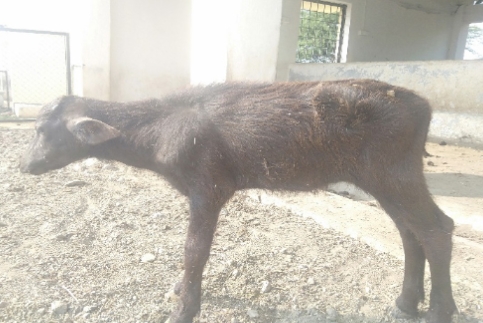Scorpion envenomation in buffalo calf - Case report
DOI:
https://doi.org/10.56825/bufbu.2022.4123160Keywords:
Bubalus bubalis, buffalo calf, haemato-biochemistry, scorpion envenomation, treatmentAbstract
Scorpion bit a three-month-old male buffalo calf of college sub-center in evening hours followed by rapid onset of clinical signs. Acute signs with lateral recumbency, paddling of legs, bellowing, nystagmus, frequent urination was observed in a calf. Clinical examination revealed subnormal body temperature (97.9oF), tachycardia (88/minute) and tachypnea (40/minute) with hyperemic conjunctival mucous membranes. Haematology showed severe leukocytosis (17.65x103/μl) while biochemistry showed slightly elevated serum total bilirubin (0.79 mg/dl) with normal blood urea nitrogen (25 mg/dl) and creatinine (1.4 mg/dl) values. Centrifugation of both whole blood sample in EDTA vial and clot activator tube showed haemolysed plasma and serum. Based on the evidence of scorpion bite, buffalo calf was treated symptomatically with Inj. Dextrose 5% 1 lit iv, Inj. Dexamethasone 0.04 mg/kg iv, Inj. Diazepam 1 mg/kg iv and Inj. Chlorpheniramine maleate 0.2 mg/kg im. Clinical signs of pain, nystagmus, bellowing, and excitation were subsided within half hour post-treatment while vital parameters were restored to normal after 12 h. A second treatment comprising of 1 liter Dextrose 5% 12 h later was followed by appreciable clinical improvement with resumption of normal suckling, feeding, and watering in treated calf. In conclusion, scorpion bite in bovines can be treated symptomatically with fluids, steroids, anti-allergic drugs, and sedatives in severe cases of nervous excitatory symptoms.
Downloads
Metrics
References
Bawaskar, H.S. 1982. Diagnostic cardiac premonitory signs and symptoms of red scorpion sting. Lancet, 1(8271): 552-554 . DOI: 10.1016/s0140-6736(82)92057-8
Bawaskar, H.S. and P.H. Bawaskar. 2012. Scorpion Sting: Update. Journal of the Association of Physicians of India, 60: 46-55.
Bawaskar, H.S. and P.H. Bawaskar. 1998. Indian red scorpion envenoming. Indian J. Pediatr., 65(3): 383-391. DOI: 10.1007/BF02761131
Bawaskar, H.S. and P.H. Bawaskar. 1986. Prazosin in management of cardiovascular manifestations of scorpion sting. Lancet, 1(8479): 510-511. DOI: 10.1016/s0140-6736(86)92979-x
Cardoso, M.J.L., M. Sakate, P. Ciampolinin, F.Q. Moutinho and A.L. Cherubini. 2004. Envenomation by scorpion in dog-Case report. J. Venom. Anim. Toxins., 10(1): 98-105. DOI: 10.1590/S1678-91992004000100008
Ebrahim, R. and M.R. Elaheh. 2008. Asymmetric pulmonary edema after scorpion sting: A case report. Rev. I. Med. Trop., 50(6): 347-350. DOI: 10.1590/S0036-46652008000600007
Gajalakshmi, B.S., N. Ramaswamy, C. Thiagarajan and G.M. Yaha. 1978. Certain observations in electrocardiogram and enzyme variation in dogs, following scorpion venom injection. Indian Journal of Physiology and Pharmacology, 22(4): 397-400.
Ismail, M. 1995. The scorpion envenoming syndrome. Toxicon, 33(7): 825-858. DOI: 10.1016/0041-0101(95)00005-7
Mebs, D. 2002. Scorpions and snakes, such as cobras, mambas and vipers made the African continent famous for venomous animals, B. Soc. Pathol. Exot., 95(3): 131.
Petricevich, V.L. 2002. Scorpion venom and the inflammatory response. Mediat. Inflamm., 2010: 903295. DOI: 10.1155/2010/903295
Radha Krishna Murty, K. and M.A. Zare. 2001. The use of antivenom reverses hematological and osmotic fragility changes of erythrocytes caused by Indian red scorpion Mesobuthus tamulus concanesis POCOCK in experimental envenoming. J. Venom. Anim. Toxins, 7(1): 113-138. Available on: https://dx.doi.org/10.1590/S0104-79302001000100008
Radostits, O.M., C.C. Gay, K.W. Hinchcliff and P.D. Constable. 2010. Veterinary Medicine: A Textbook of The Diseases of Cattle, Sheep, Pigs, Goats and Horses, 10th ed. Saunders Elsevier Co., London, UK.









.png)








